Optimizing Ventilation Strategies for Thermal Comfort in Mediterranean Schools: A Dynamic Modeling Approach
Abstract
:1. Introduction
2. Materials and Methods
- Climate Classification and Heating Regulations for the School Building in Lecce (Section 2.1)
- Layout of the Prototype Primary School Building (Section 2.2)
- Dynamic Thermal Assessment of the School Building Using Termolog EpiX 15 (Section 2.3)
2.1. Climate Classification and Heating Regulations for the School Building in Lecce
2.2. Layout of the Prototype Primary School Building
2.3. Dynamic Thermal Assessment of the School Building Using Termolog EpiX 15
- cooling and heating temperatures (set point and set back);
- occupancy profiles and internal contributions due to the presence of people, machines, and lighting;
- hourly air exchange of the envelope;
- hourly internal vapor production;
- hourly usage profiles of movable shading devices on windows.
- hr is the linear radiative heat transfer coefficient [W/m2C];
- Tmr is the mean radiant temperature [°C];
- hc is the convective heat transfer coefficient [W/m2C];
- Tdb is the dry bulb temperature [°C].
- θ0 is indoor operative temperature [°C];
- θrm is weighted average external temperature [°C].
3. Results and Discussion
Influence of Different Air Changes on Thermal Comfort for Each Month
4. Conclusions
Author Contributions
Funding
Data Availability Statement
Conflicts of Interest
References
- Díaz-López, C.; Serrano-Jiménez, A.; Verichev, K.; Barrios-Padura, Á. Passive cooling strategies to optimise sustainability and environmental ergonomics in Mediterranean schools based on a critical review. Build. Environ. 2022, 221, 109297. [Google Scholar] [CrossRef]
- Krawczyk, D.A. Theoretical and real effect of the school’s thermal modernization—A case study. Energy Build. 2014, 81, 30–37. [Google Scholar] [CrossRef]
- Romano, R.; Donato, A.; Gallo, P. Retrofit Strategies Optimization Based on Indoor Comfort Analysis Under Real Conditions: The Case Study of the Secondary School ITC Carrara. Smart Innov. Syst. Technol. 2022, 263, 231–241. [Google Scholar]
- Díaz-López, C.; Serrano-Jiménez, A.; Lizana, J.; López-García, E.; Molina-Huelva, M.; Barrios-Padura, Á. Passive action strategies in schools: A scientific mapping towards eco-efficiency in educational buildings. J. Build. Eng. 2022, 45, 103598. [Google Scholar] [CrossRef]
- Serrano-Jiménez, A.; Femenías, P.; Thuvander, L.; Barrios-Padura, Á. A multi-criteria decision support method towards selecting feasible and sustainable housing renovation strategies. J. Clean. Prod. 2021, 278, 123588. [Google Scholar] [CrossRef]
- Congedo, P.M.; Palmieri, A.; Baglivo, C. Climate resilience strategies for schools in mediterranean areas: Is it feasible to condition air merely with ventilation? Energy Effic. 2025, 18, 24. [Google Scholar] [CrossRef]
- Abbass, K.; Qasim, M.Z.; Song, H.; Murshed, M.; Mahmood, H.; Younis, I. A review of the global climate change impacts, adaptation, and sustainable mitigation measures. Environ. Sci. Pollut. Res. 2022, 29, 42539–42559. [Google Scholar] [CrossRef]
- Maiques, M.; Tarragona, J.; Gangolells, M.; Casals, M. Energy implications of meeting indoor air quality and thermal comfort standards in Mediterranean schools using natural and mechanical ventilation strategies. Energy Build. 2025, 328, 115076. [Google Scholar] [CrossRef]
- Landrigan, P.J.; A Kimmel, C.; Correa, A.; Eskenazi, B. Children’s health and the environment: Public health issues and challenges for risk assessment. Environ. Health Perspect. 2004, 112, 257–265. [Google Scholar] [CrossRef]
- Haverinen-Shaughnessy, U.; Shaughnessy, R.J.; Cole, E.C.; Toyinbo, O.; Moschandreas, D.J. An assessment of indoor environmental quality in schools and its association with health and performance. Build. Environ. 2015, 93, 35–40. [Google Scholar] [CrossRef]
- Jendrossek, S.N.; Jurk, L.A.; Remmers, K.; Cetin, Y.E.; Sunder, W.; Kriegel, M.; Gastmeier, P. The Influence of Ventilation Measures on the Airborne Risk of Infection in Schools: A Scoping Review. Int. J. Environ. Res. Public Health 2023, 20, 3746. [Google Scholar] [CrossRef] [PubMed]
- Jia, L.-R.; Han, J.; Chen, X.; Li, Q.-Y.; Lee, C.-C.; Fung, Y.-H. Interaction between Thermal Comfort, Indoor Air Quality and Ventilation Energy Consumption of Educational Buildings: A Comprehensive Review. Buildings 2021, 11, 591. [Google Scholar] [CrossRef]
- Cabovská, B.; Bekö, G.; Teli, D.; Ekberg, L.; Dalenbäck, J.-O.; Wargocki, P.; Psomas, T.; Langer, S. Ventilation strategies and indoor air quality in Swedish primary school classrooms. Build. Environ. 2022, 226, 109744. [Google Scholar] [CrossRef]
- Srivastava, S.; Zhao, X.; Manay, A.; Chen, Q. Effective ventilation and air disinfection system for reducing coronavirus disease 2019 (COVID-19) infection risk in office buildings. Sustain. Cities Soc. 2021, 75, 103408. [Google Scholar] [CrossRef]
- Pan, C.-Y.; Weng, K.-T.; Hsu, H.-C. Air change per hour improvement for positive and negative pressure mechanical ventilation facilities systems. J. Build. Eng. 2024, 83, 108414. [Google Scholar] [CrossRef]
- Nasrollahi, N.; Ghobadi, P. Field measurement and numerical investigation of natural cross-ventilation in high-rise buildings; Thermal comfort analysis. Appl. Therm. Eng. 2022, 211, 118500. [Google Scholar] [CrossRef]
- Chen, Y.-H.; Tu, Y.-P.; Sung, S.-Y.; Weng, W.-C.; Huang, H.-L.; Tsai, Y.I. A comprehensive analysis of the intervention of a fresh air ventilation system on indoor air quality in classrooms. Atmos. Pollut. Res. 2022, 13, 101373. [Google Scholar] [CrossRef]
- Li, H.; Liu, M.; Kong, X.; Wang, L.; Li, J.; Fan, M. Experimental research on energy utilization, aerosol transmission and thermal comfort under different ventilation strategies: Densely-occupied classrooms as a case study. Build. Environ. 2025, 270, 112523. [Google Scholar] [CrossRef]
- Schulze, T.; Eicker, U. Controlled natural ventilation for energy efficient buildings. Energy Build. 2013, 56, 221–232. [Google Scholar] [CrossRef]
- Wargocki, P.; Porras-Salazar, J.A.; Contreras-Espinoza, S.; Bahnfleth, W. The relationships between classroom air quality and children’s performance in school. Build. Environ. 2020, 173, 106749. [Google Scholar] [CrossRef]
- Baglivo, C.; Bonomolo, M.; Congedo, P.M.; Beccali, M.; Antonaci, S. Technical-Economic Evaluation of the Effectiveness of Measures Applied to the Artificial Lighting System of a School. Appl. Sci. 2021, 11, 6664. [Google Scholar] [CrossRef]
- Congedo, P.M.; Baglivo, C.; Seyhan, A.K.; Marchetti, R. Worldwide dynamic predictive analysis of building performance under long-term climate change conditions. J. Build. Eng. 2021, 42, 103057. [Google Scholar] [CrossRef]
- Firman, N.S.; Zaki, S.A.; Tuck, N.W.; Singh, M.K.; Rijal, H.B. A study on adaptive thermal comfort and ventilation in Malaysia secondary school classrooms of tropical climate. Build. Environ. 2025, 273, 112701. [Google Scholar] [CrossRef]
- Karakas, F.; Grassie, D.; Schwartz, Y.; Dong, J.; Bagkeris, E.; Mumovic, D.; Milner, J.; Chalabi, Z.; Mavrogianni, A. A Multi-Criteria decision analysis framework to determine the optimal combination of energy efficiency and indoor air quality schemes for English school classrooms. Energy Build. 2023, 295, 113293. [Google Scholar] [CrossRef]
- Baglivo, C. Dynamic Evaluation of the Effects of Climate Change on the Energy Renovation of a School in a Mediterranean Climate. Sustainability 2021, 13, 6375. [Google Scholar] [CrossRef]
- Ashrafian, T. Enhancing school buildings energy efficiency under climate change: A comprehensive analysis of energy, cost, and comfort factors. J. Build. Eng. 2023, 80, 107969. [Google Scholar] [CrossRef]
- Buyak, N.; Deshko, V.; Bilous, I.; Pavlenko, A.; Sapunov, A.; Biriukov, D. Dynamic interdependence of comfortable thermal conditions and energy efficiency increase in a nursery school building for heating and cooling period. Energy 2023, 283, 129076. [Google Scholar] [CrossRef]
- UNI EN ISO 52016-1:2018; Prestazione Energetica Degli Edifici—Fabbisogni Energetici per Riscaldamento e Raffrescamento, Temperature Interne e Carichi Termici Sensibili e Latenti—Parte 1: Procedure di Calcolo. Ente Nazionale Italiano di Unificazione (UNI): Milan, Italy, 2018.
- Arnfield, A.J. Classificazione Climatica di Köppen. Enciclopedia Britannica, 16 October 2023. Available online: https://www.britannica.com/science/Koppen-climate-classification (accessed on 19 December 2023).
- DPR 412/1993; Italian Presidential Decree, Regolamento Recante Norme per la Progettazione, L’installazione, L’esercizio e la Manutenzione degli Impianti Termici degli Edifici ai fini del Contenimento dei Consumi di Energia, in Attuazione Dell’art. 4, Comma 4, della Legge 9 Gennaio. Gazzetta Ufficiale della Repubblica Italiana: Rome, Italy, 1993.
- M.D. 18/12/1975; Italian Ministerial Decree, Norme Tecniche Aggiornate Relative All’edilizia Scolastica, ivi Compresi gli Indici di Funzionalità Didattica, Edilizia ed Urbanistica, da Osservarsi Nella Esecuzione di Opere di Edilizia Scolastica. Gazzetta Ufficiale della Repubblica Italiana: Rome, Italy, 1975.
- M.D. 26/6/2015; Italian Ministerial Decree, Applicazione delle Metodologie di Calcolo delle Prestazioni Energetiche e Definizione delle Prescrizioni e dei Requisiti Minimi degli Edifici. Gazzetta Ufficiale della Repubblica Italiana: Rome, Italy, 2015. (In Italian)
- Congedo, P.M.; Baglivo, C.; Centonze, G. Walls comparative evaluation for the thermal performance improvement of low-rise residential buildings in warm Mediterranean climate. J. Build. Eng. 2020, 28, 101059. [Google Scholar] [CrossRef]
- UNI 10375:2011; Metodo di Calcolo della Temperatura Interna estiva degli Ambienti. Ente Nazionale Italiano di Unificazione (UNI): Milan, Italy, 2011.
- UNI EN 16798-1:2019; Prestazione Energetica degli Edifici—Ventilazione per gli Edifici—Parte 1: Parametri di Ingresso Dell’ambiente Interno per la Progettazione e la Valutazione della Prestazione Energetica degli Edifici in Relazione alla Qualità Dell’aria Interna, All’ambiente Termico, All’illuminazione e All’acustica—Modulo M1-6. Ente Nazionale Italiano di Unificazione (UNI): Milan, Italy, 2019.
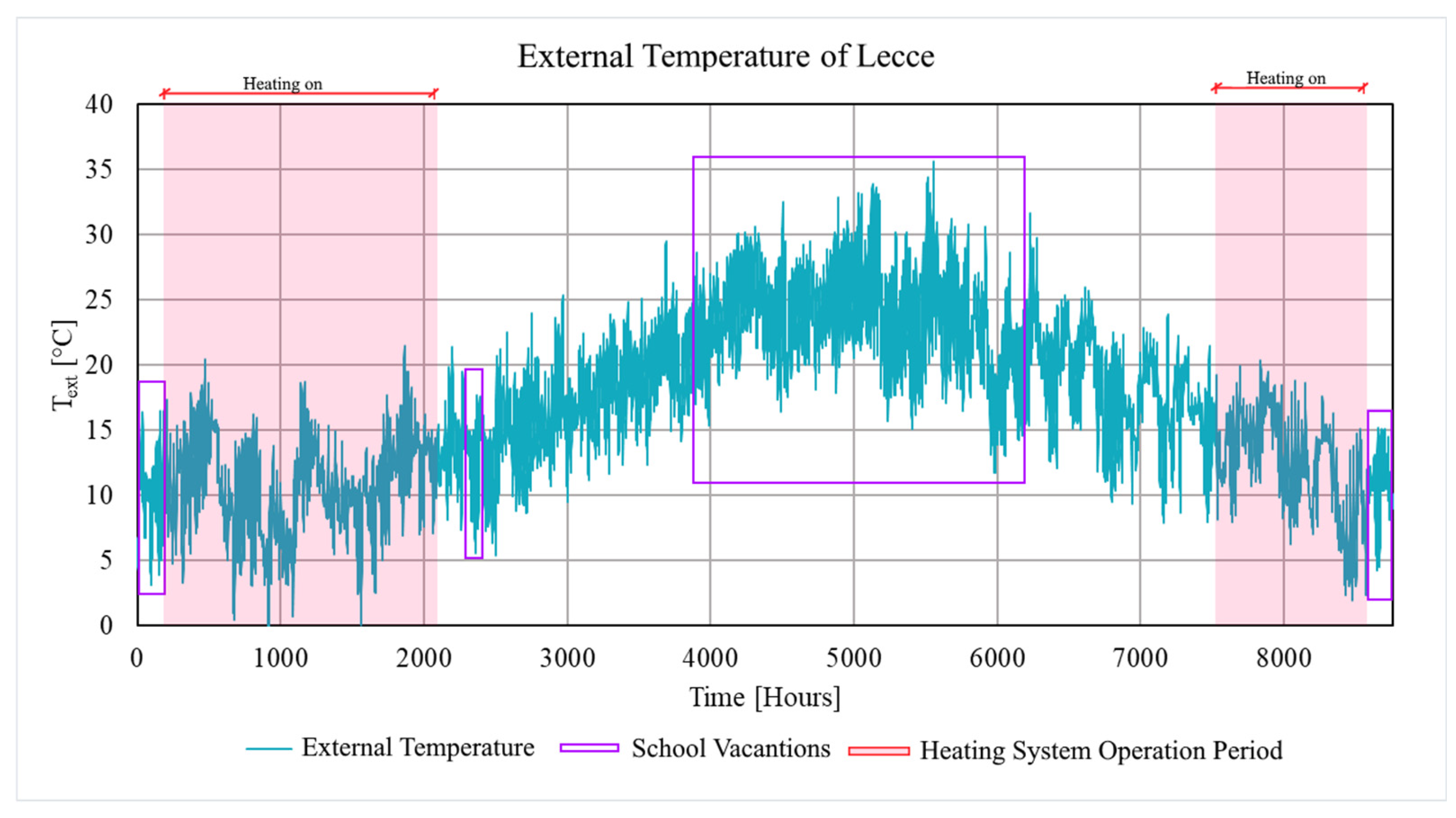
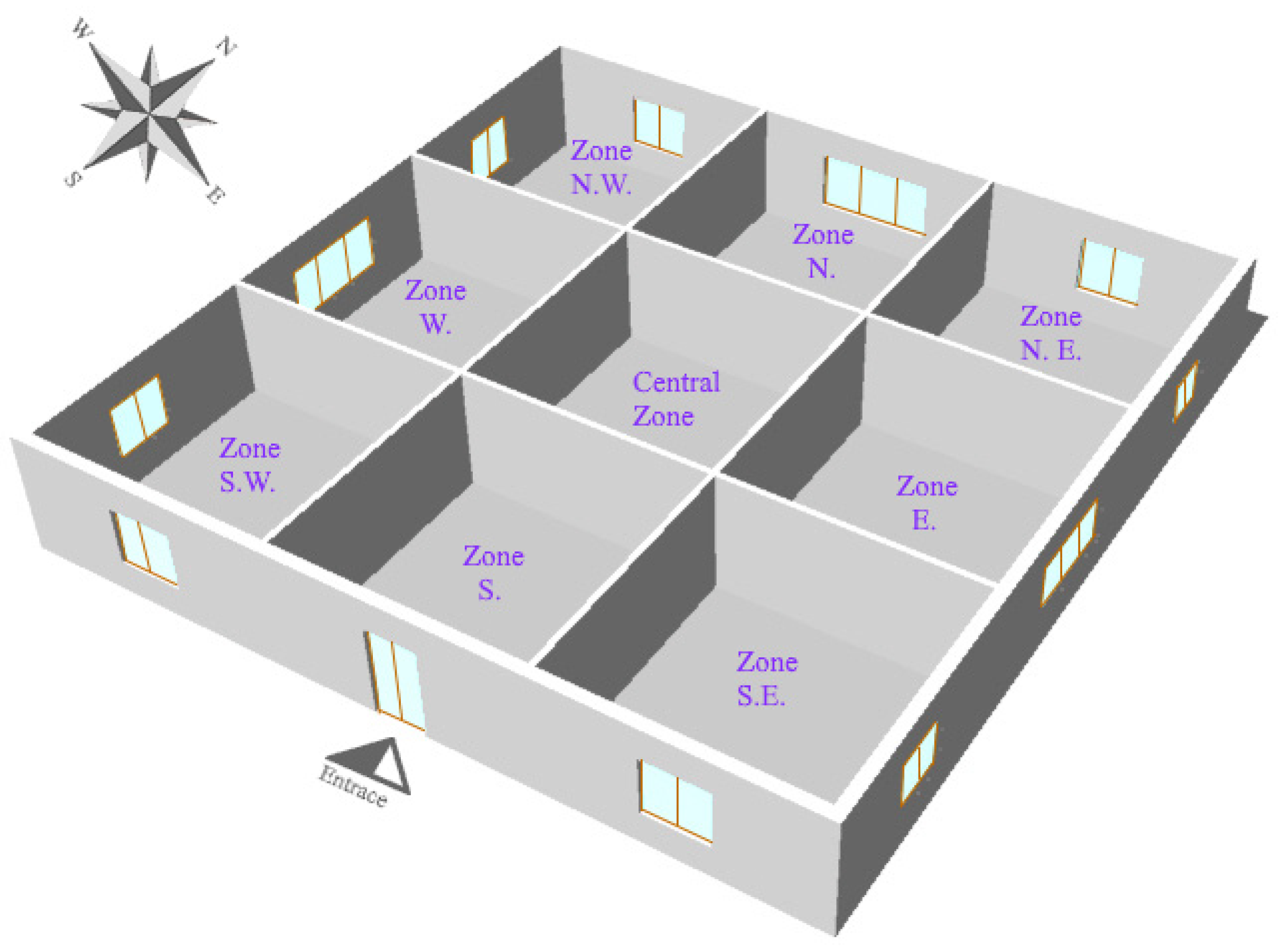


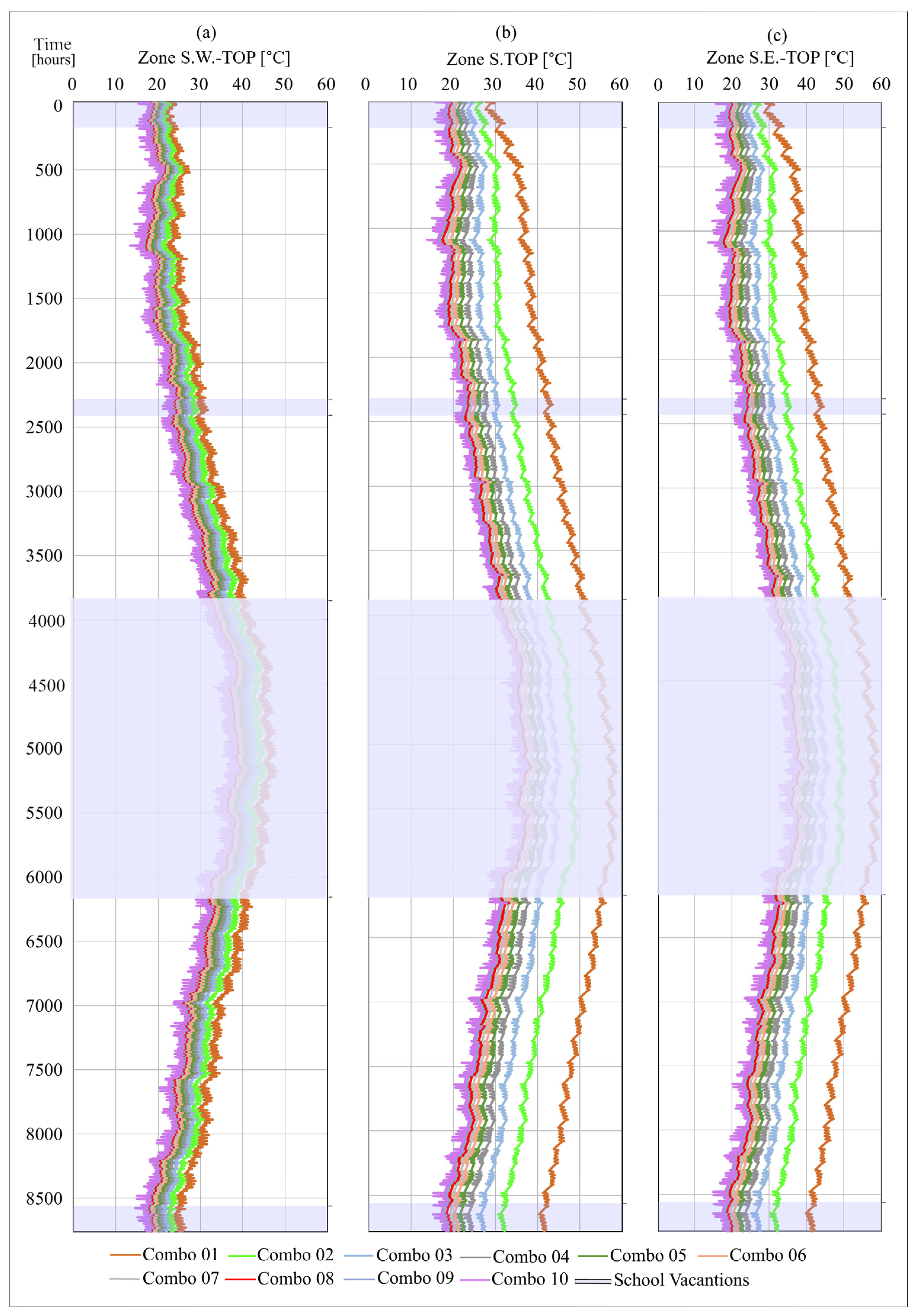

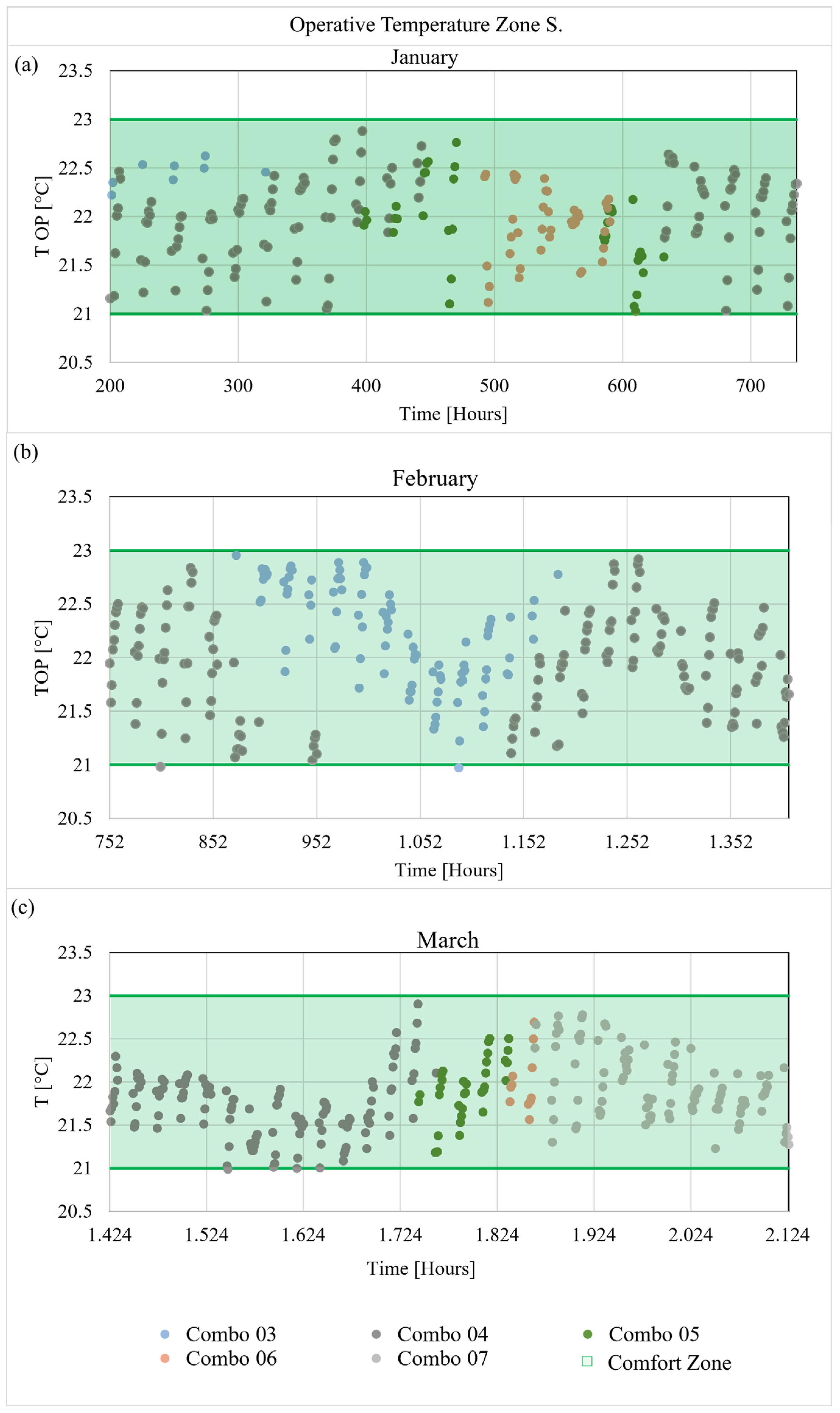

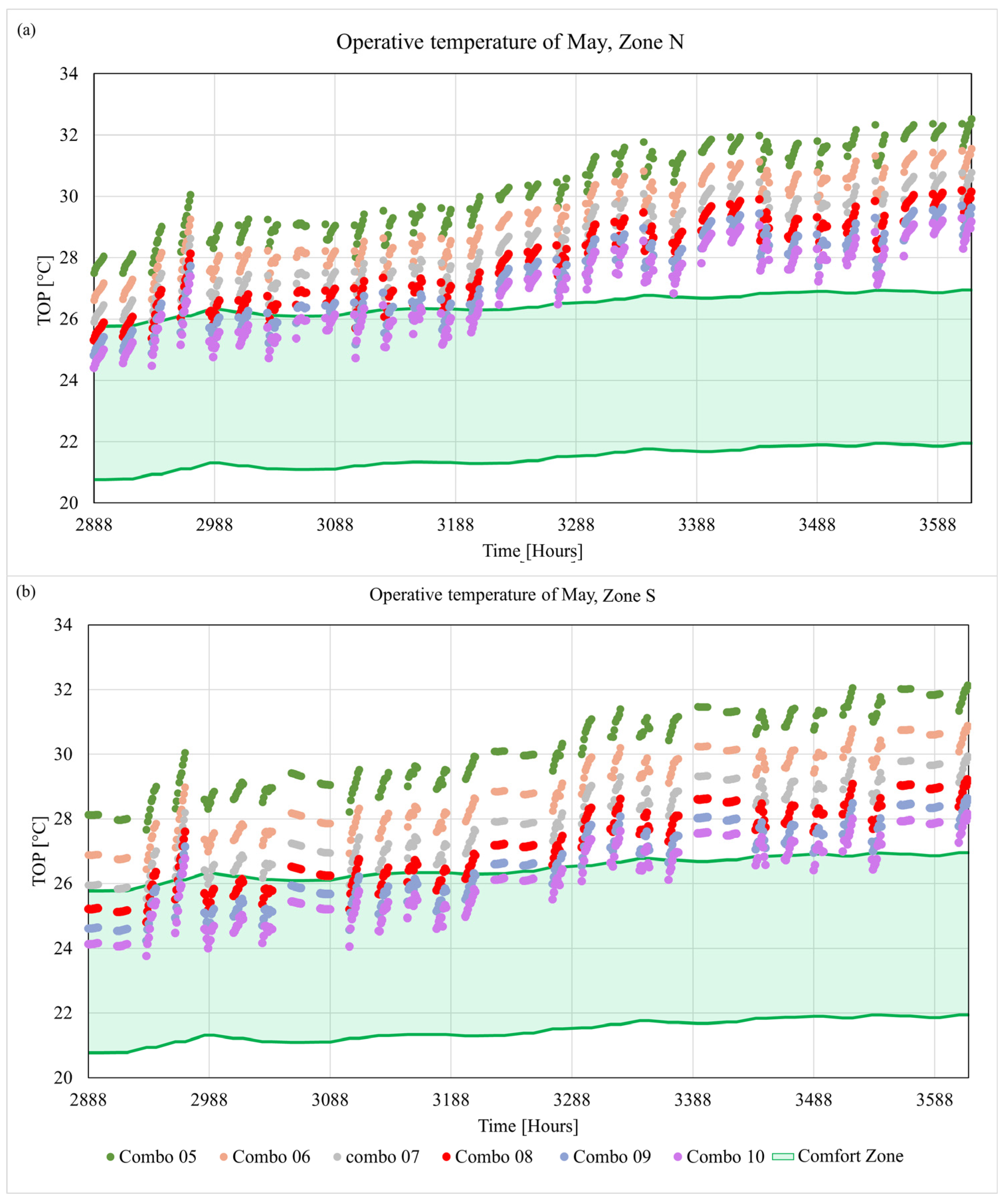
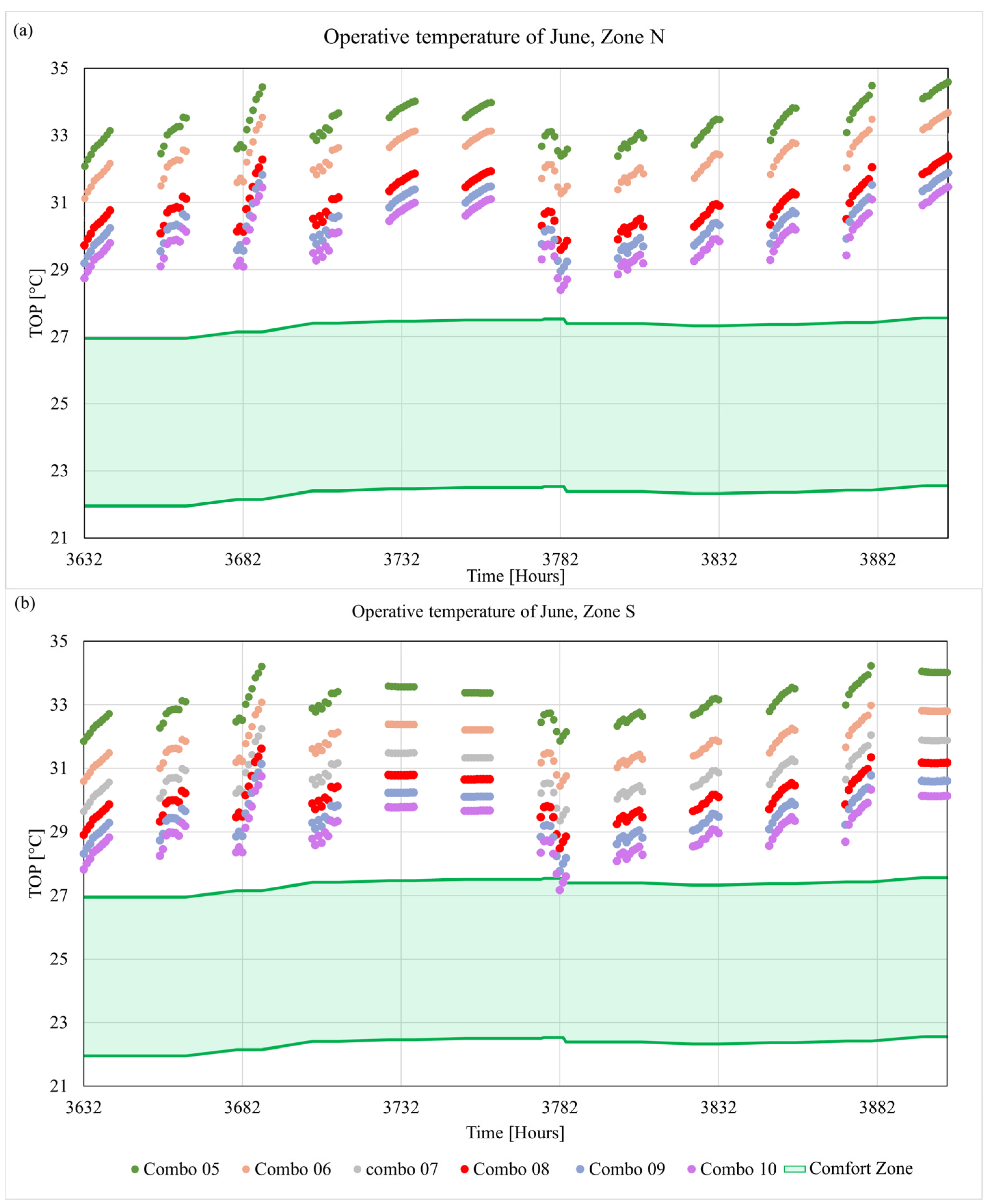
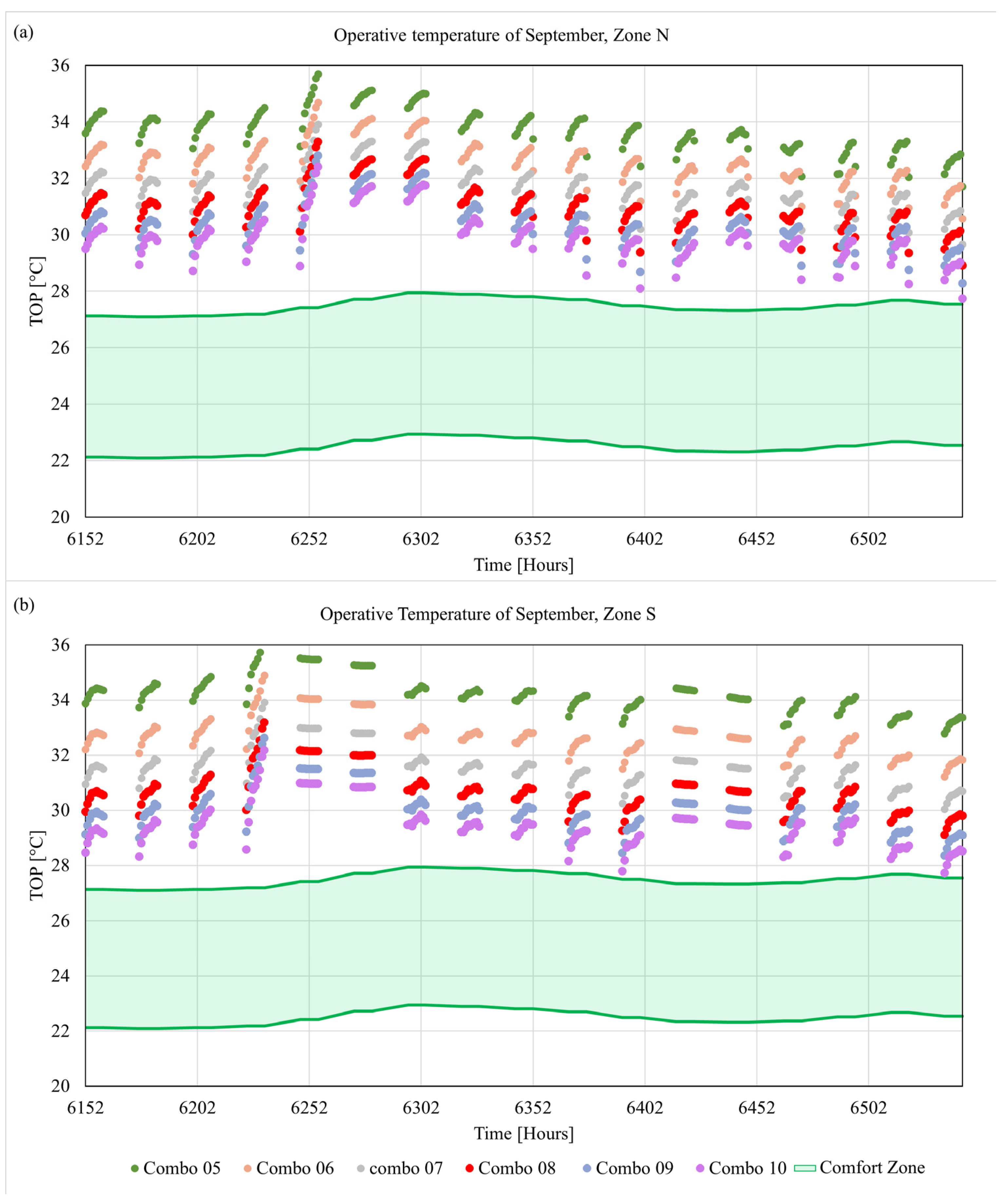

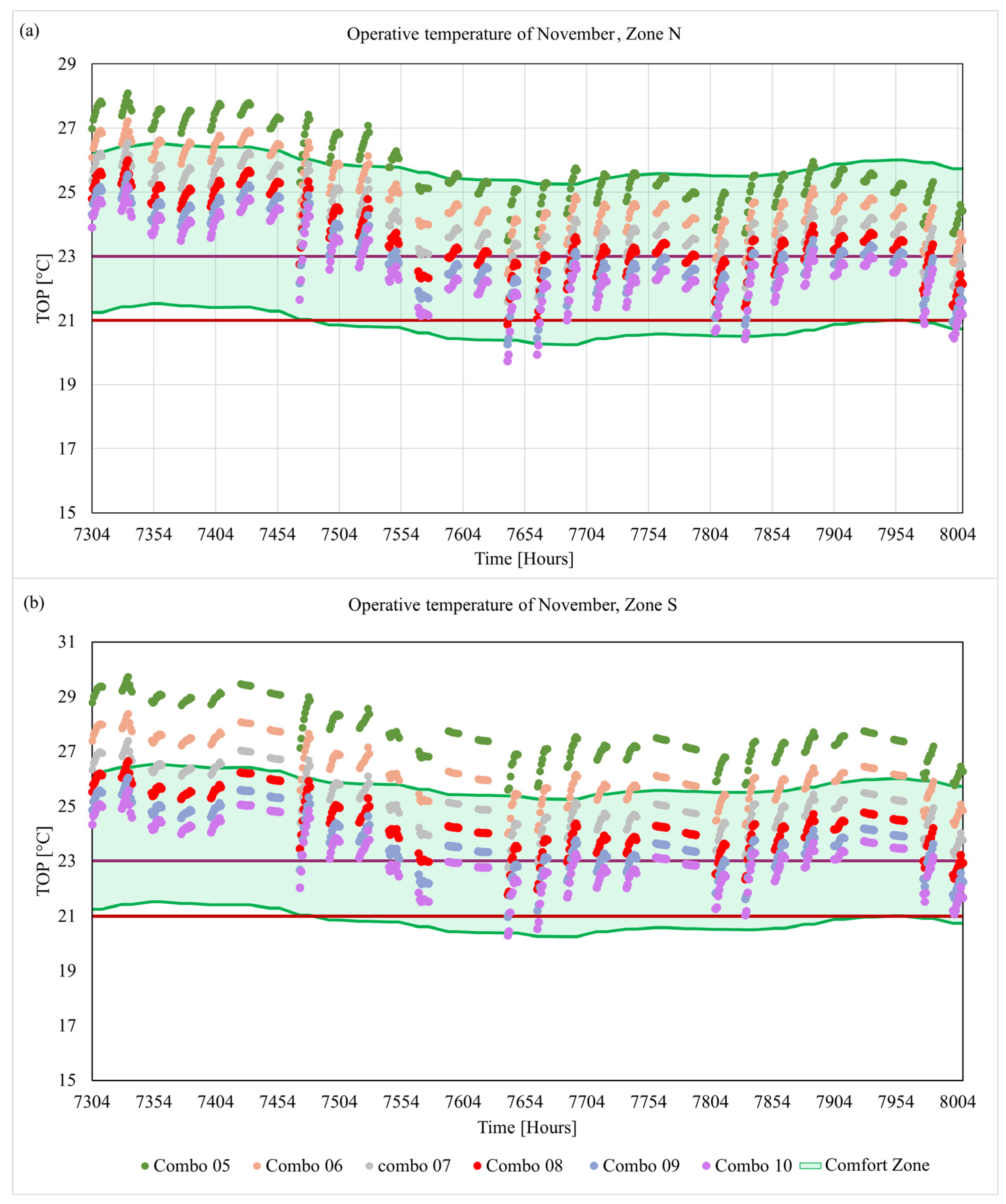

| Component | Layers | d [mm] | ρ [kg/m3] | λ [W/mK] | C [kJ/KgK] |
|---|---|---|---|---|---|
| Below ground floor Uset = 0.764 W/m2K Ulim = 0.84 W/m2K  | Internal adductance | 5.88 | 1 | ||
| Floor tiles | 10 | 2300 | 1.0 | 0.84 | |
| Cement mortar | 10 | 2000 | 1.4 | 1 | |
| Ordinary concrete screed | 80 | 1700 | 1.1 | 1 | |
| Vapor barrier | 0.5 | 360 | 0.4 | 1.5 | |
| Extruded polystyrene (XPS) | 20 | 24 | 0.032 | 1.45 | |
| Bituminous waterproofing membrane—RADON barrier | 5 | 1200 | 0.2 | 1 | |
| Reinforced concrete | 80 | 2400 | 1.91 | 1 | |
| Underfloor cavity with ventilated cavity | 200 | 1.2 | 1.39 | 1 | |
| Lean concrete | 80 | 2200 | 1.0 | 1 | |
| Coarse gravel without clay | 150 | 1700 | 1.2 | 0.84 | |
| Roof Uset = 0.317 W/m2K Ulim = 0.33 W/m2K  | Internal adductance | 10 | 1 | ||
| Internal plaster | 10 | 1400 | 0.7 | 1 | |
| Slab blocks with lightening elements in place | 260 | 1800 | 0.743 | 1 | |
| Vapor barrier | 0.5 | 360 | 0.4 | 1.5 | |
| Extruded polystyrene (XPS) | 80 | 24 | 0.032 | 1.45 | |
| Bituminous waterproofing membrane | 5 | 1200 | 0.17 | 1 | |
| Concrete | 100 | 1800 | 0.94 | 0.88 | |
| Concrete substrate—cement mortar | 10 | 2000 | 1.4 | 1 | |
| Ceramic tiles | 10 | 2300 | 1.3 | 0.84 | |
| External adductance | 25 | 1 | |||
| External wall Uset = 0.308 W/m2K Ulim = 0.34 W/m2K  | Internal adductance | 7.69 | 1 | ||
| Internal plaster | 10 | 1400 | 0.7 | 1 | |
| Brick blocks | 250 | 1000 | 0.4 | 1 | |
| Expanded Polystyrene (EPS) | 80 | 24 | 0.033 | 1.45 | |
| External plaster | 10 | 1800 | 0.9 | 1 | |
| External adductance | 25.0 | 1 |
| French Door | Central Window | Lateral Window |
|---|---|---|
| Uw,set = 1.926 W/m2K Uw,lim = 2.200 W/m2K | Uw,set = 2.009 W/m2K Uw,lim = 2.200 W/m2K | Uw,set = 2.004 W/m2K Uw,lim = 2.200 W/m2K |
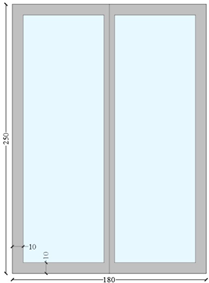 | 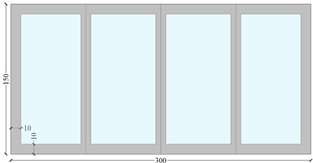 |  |
| Combo | Thermal Power Transmission φt [kW] | Thermal Power Ventilation φv [kW] | Reheat Thermal Power φrh [kW] | Total Thermal Load φhl [kW] |
|---|---|---|---|---|
| 1 | 6.39 | 7.97 | 5.83 | 20.19 |
| 2 | 6.39 | 14.58 | 5.83 | 26.80 |
| 3 | 6.39 | 21.19 | 5.83 | 33.40 |
| 4 | 6.39 | 27.80 | 5.83 | 40.01 |
| 5 | 6.39 | 34.41 | 5.83 | 46.62 |
| 6 | 6.39 | 41.02 | 5.83 | 53.23 |
| 7 | 6.39 | 46.89 | 5.83 | 59.11 |
| 8 | 6.39 | 54.24 | 5.83 | 66.45 |
| 9 | 6.39 | 60.11 | 5.83 | 72.33 |
| 10 | 6.39 | 67.45 | 5.83 | 79.67 |
| Combo | Capacity (m3/h) | Max. Power Consumption (W) | Max. Power Consumption (kW) | Hours of Operation [h] | Daily Energy Consumption [kWh] |
|---|---|---|---|---|---|
| 1 | 108 | 134.26 | 0.13 | 8 | 1.07 |
| 2 | 216 | 135.90 | 0.14 | 8 | 1.09 |
| 3 | 324 | 142.23 | 0.14 | 8 | 1.14 |
| 4 | 432 | 150.00 | 0.15 | 8 | 1.20 |
| 5 | 540 | 196.95 | 0.20 | 8 | 1.58 |
| 6 | 648 | 331.21 | 0.33 | 8 | 2.65 |
| 7 | 756 | 332.85 | 0.33 | 8 | 2.66 |
| 8 | 864 | 339.18 | 0.34 | 8 | 2.71 |
| 9 | 972 | 346.95 | 0.35 | 8 | 2.78 |
| 10 | 1080 | 393.90 | 0.39 | 8 | 3.15 |
Disclaimer/Publisher’s Note: The statements, opinions and data contained in all publications are solely those of the individual author(s) and contributor(s) and not of MDPI and/or the editor(s). MDPI and/or the editor(s) disclaim responsibility for any injury to people or property resulting from any ideas, methods, instructions or products referred to in the content. |
© 2025 by the authors. Licensee MDPI, Basel, Switzerland. This article is an open access article distributed under the terms and conditions of the Creative Commons Attribution (CC BY) license (https://creativecommons.org/licenses/by/4.0/).
Share and Cite
Congedo, P.M.; Palmieri, A.; Baglivo, C. Optimizing Ventilation Strategies for Thermal Comfort in Mediterranean Schools: A Dynamic Modeling Approach. Energies 2025, 18, 1542. https://doi.org/10.3390/en18061542
Congedo PM, Palmieri A, Baglivo C. Optimizing Ventilation Strategies for Thermal Comfort in Mediterranean Schools: A Dynamic Modeling Approach. Energies. 2025; 18(6):1542. https://doi.org/10.3390/en18061542
Chicago/Turabian StyleCongedo, Paolo Maria, Andrea Palmieri, and Cristina Baglivo. 2025. "Optimizing Ventilation Strategies for Thermal Comfort in Mediterranean Schools: A Dynamic Modeling Approach" Energies 18, no. 6: 1542. https://doi.org/10.3390/en18061542
APA StyleCongedo, P. M., Palmieri, A., & Baglivo, C. (2025). Optimizing Ventilation Strategies for Thermal Comfort in Mediterranean Schools: A Dynamic Modeling Approach. Energies, 18(6), 1542. https://doi.org/10.3390/en18061542








